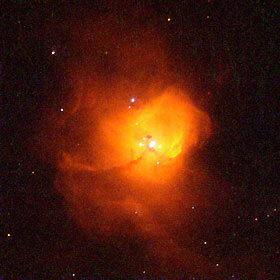
Enregistrez gratuitement cette image
en 800 pixels pour usage maquette
(click droit, Enregistrer l'image sous...)
|
|
Réf : S02603
Thème :
Nébuleuses (144 images)
Titre : N81 in the Small Magellanic Cloud
Description : (La description de cette image n'existe qu'en anglais)
A NASA Hubble Space Telescope 'family portrait' of young, ultra-bright stars nested in their embryonic cloud of glowing gases. The celestial maternity ward, called N81, is located 200,000 light-years away in the Small Magellanic Cloud (SMC), a small irregular satellite galaxy of our Milky Way. Hubble's exquisite resolution allows astronomers to pinpoint 50 separate stars tightly packed in the nebula's core within a 10 light- year diameter - slightly more than twice the distance between earth and the nearest star to our sun. The closest pair of stars is only 1/3 of a light-year apart (0.3 arcseconds in the sky). This furious rate of mass loss from these super-hot stars is evident in the Hubble picture that reveals dramatic shapes sculpted in the nebula's wall of glowing gases by violent stellar winds and shock waves. A pair of bright stars in the center of the nebula is pouring out most of the ultraviolet radiation to make the nebula glow. Just above them, a small dark knot is all that is left of the cold cloud of molecular hydrogen and dust the stars were born from. Dark absorption lanes of residual dust trisect the nebula. The nebula offers a unique opportunity for a close-up glimpse at the firestorm' accompanying the birth of extremely massive stars, each blazing with the brilliance of 300,000 of our suns. Such galactic fireworks were much more common billions of years ago in the early universe, when most star formation took place. The 'natural- color' view was assembled from separate images taken with the Wide Field and Planetary Camera 2, in ultraviolet light and two narrow emission lines of ionized Hydrogen (H-alpha, H-beta).
|
|

